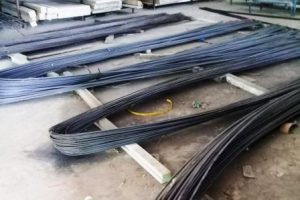Steel For a House in Thailand.
Types of steel for roof structure and concrete reinforcing.
Deformed steel reinforcing bar is referred to as ‘rebar’.
On the engineers plans and specifications it might be referred to as ‘DB’ or ‘db’.
Rebar comes in different diameters and different grades.
The common type of deformed rebar used in house construction is 12 mm. – grade 40.
The grade of the 12 mm rebar can be 30, 40, or 50 with 50 being the strongest.
The 40 grade rebar is most commonly used in house construction and available.
The 50 grade rebar is not available everywhere – I found it at ‘Global World’ store, Hang Dong.
Notes – It is advisable to buy the 12 mm rebar yourself and have it delivered to the job site.
The grade 50 rebar from Global World has the 50 molded into the bar, it is not easy to see the marking.
The softer grades of rebar may not be marked and to a beginner cannot be distinguished apart.
The stronger steel is more expensive, in Thailand, it is not uncommon for a builder to use the cheapest steel so as to make more money, be aware.
All rebar steel comes in 10 meter lengths and is folded as seen in the image.
This fold is annoying as it takes some time to straighten the steel and there doesn’t seem to be an easy way to do this.
So – grade 40 is most commonly used, but grade 50, 12 mm rebar, is the best to used when building a house in Thailand.
Maybe the lower grade steel is sufficient with a single story house.
Round reinforcing steel bar is referred to as ’round bar’.
On the engineers plans and specifications it might be referred to as ‘RB’ or ‘rb’.
The common diameters used are 6 mm and 9 mm. Length is 10 meters and grade is mild steel.
These are readily available at builders hardware stores.
The 6 mm round bar is used for the reinforcing in poured concrete floors.
(The concrete floor that is poured over the concrete planks for the upper floor can have a weld mesh type of reinforcing.)
The 9 mm round bar is used in door and window frames, heads above openings and stairs. 9 mm is also used for reinforcing fences and similar non heavy load bearing structured.
Steel for roof construction.
Beams, rafters and battens.
Square section steel tube is a primary building product in Thailand.
C section is also common.
The steel comes in many sizes and grades, the grade is determined by the wall thickness.
Some people still refer to the sizes as 4 x 2 and 3 x 2 etc. ( inches )
The grades are clearly marked with colour, red seems to be the thicker walled.
Not all grades have the same outside dimensions, a 100 x 50 yellow is not the same size as a 100 x 50 red.
( this might be why they are often referred to as 4 x 2 ).
For beams two pieces of square or C section may be welded side by side to give the desired load bearing strength.
The steel structure for the roof is all welded together.
At Hang Dong I used for each beam, 2 off 100 mm x 50 mm x 2.3 mm wall thickness. The beams are spaced at 3.5 meter centers.
For the rafters, 100 mm x 50 mm x 2.3 mm wall thickness. The rafters are spaced at 1 meter centers.
For the battens, 100 mm x 50 mm x 20 mm C section with 2.3 mm wall thickness. The battens are spaced at 1 meter centers.
Cutting the steel on site.
If you do not have access to a drop saw than you should buy one at the very beginning of the job.
An angle grinder is needed but not much use when a lot of steel needs to be cut.
An drop saw is a viable investment, no overly expensive and could be resold when the house is finished.
Not only the reinforcing steel but the steel for the roof needs cutting.
Bending rebar on site.
A strong, heavy, long bench is needed for setting up the bending of the 12 mm rebar.
The smaller bars need bending also but the 12 mm bar requires much force.
Along the bench are fixtures to hold the steel in place and markings to set the position for the bend.
A tool made from about 12 mm rebar has a hook formed into the end to lock onto the rebar. The tool is around 1 meter long and the worker simply pulls it around to bend the rebar.
Editing now

